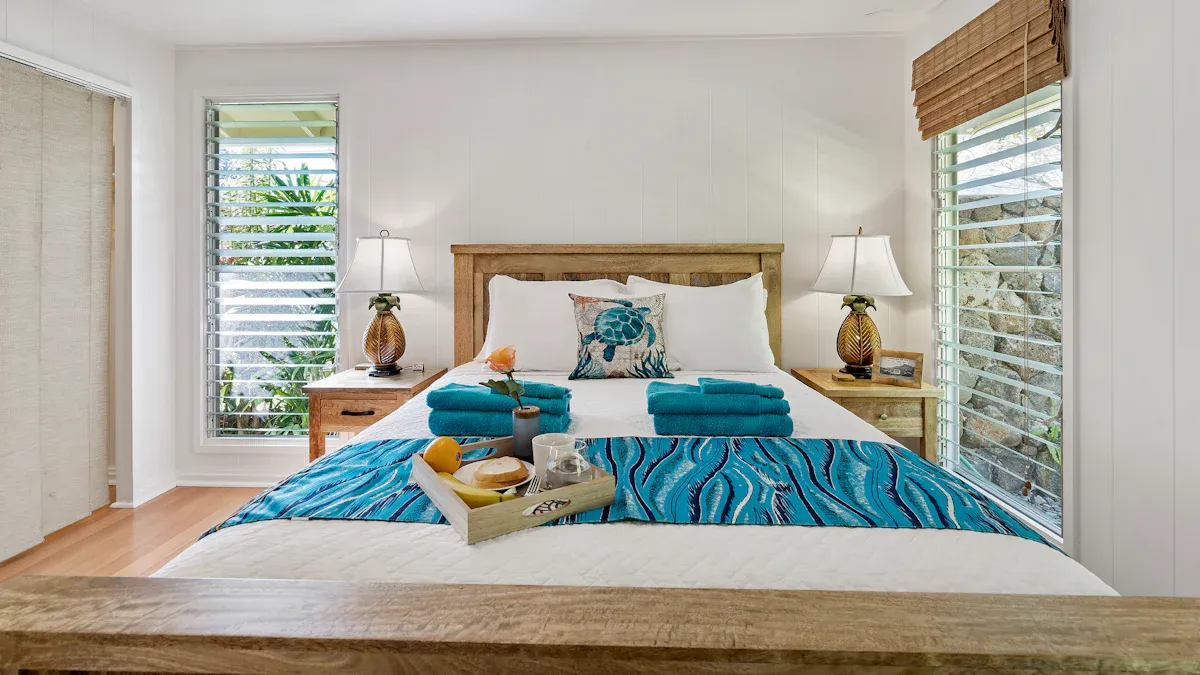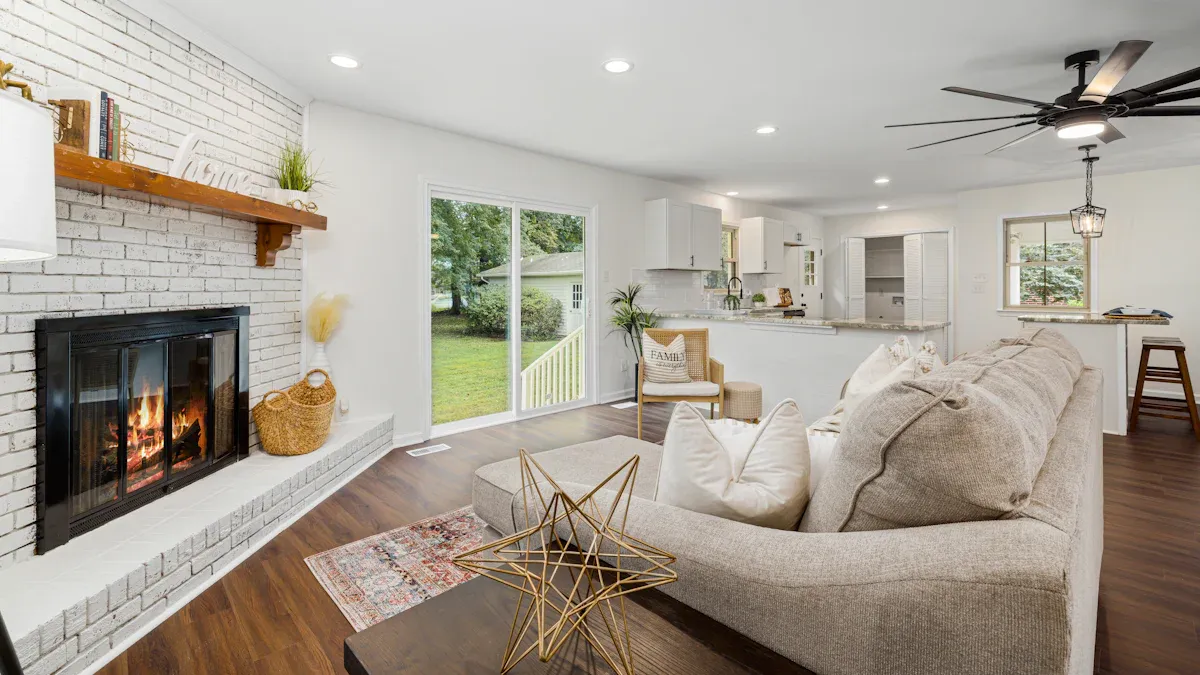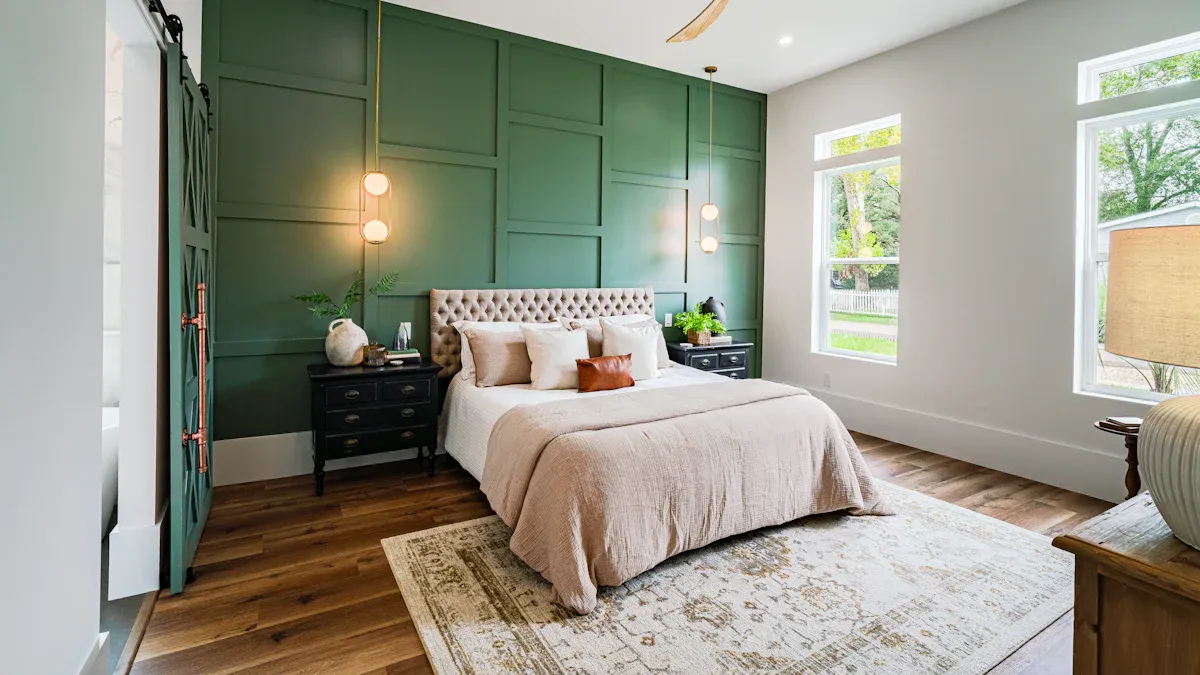
You want a home that feels good every day. That’s where feng shui and architecture work together. When you use modern design with feng shui, you boost well-being and comfort in your space. Studies show homes with modern feng shui features help people feel happier and more relaxed. Architects agree that modern design can blend ancient feng shui wisdom for real results. You don’t need special training—feng shui is flexible and fits any modern home.
Key Takeaways
Use feng shui ideas like building direction and shape. Use the five elements to make your home calm and balanced.
Put rooms and furniture in ways that help good energy move. Put living rooms in open places. Put bedrooms in quiet spots.
Let sunlight and fresh air come in to help health and happiness. Add plants to bring nature inside.
Balance earth, metal, water, wood, and fire with colors and materials. Use decor to help harmony in your home.
Begin with small steps like cleaning up clutter. Make entryways brighter. Move furniture to feel safer and more relaxed.
Feng Shui and Architecture
Key Feng Shui Principles
You may ask how feng shui and architecture work together today. Experts say it starts with where you build and how you face the building. When you plan a building, you should think about Compass School and Form School. The Compass School uses the Luo Pan compass to find the best direction for your house. This tool tells you about the 24 Mountains and 72 Dragons. It helps you plan Qi energy for balance and harmony.
The Form School looks at the shape of buildings and the land around them. Square or rectangle shapes help make things feel steady. You also use the Five Elements—fire, earth, wood, water, and metal—to create good energy. These main ideas help you design spaces that feel nice and support health.
Tip: Try using both schools when you plan your home. Use the Bagua energy map to put rooms and features in the best places for Qi flow.
Architects use these feng shui ideas to make buildings feel balanced and peaceful. Famous buildings like the HSBC Building in Hong Kong show how direction and layout can block bad energy and make people feel better. (For a deeper understanding of using Feng Shui in home aesthetics, see our detailed guide on How Feng Shui Colors Can Enhance Your Living Space.)
Energy Flow in Modern Architecture
Energy flow is very important in feng shui and building design. When you pick a place to build, look for spots that feel open and friendly. Long ago, feng shui masters used stars and land to choose the best places for buildings. Today, you can use these ideas to make homes that feel calm and close to nature.
Modern design often uses the idea of 'leaning against mountains and facing waters.' Architects like Ma Yansong use this idea to make buildings fit into the land. For example:
Two towers can stand for mountains facing a park or water.
Terraced buildings look like rice fields and mountain shapes.
Small buildings can be like rocks in a stream.
These choices help people, nature, and buildings work together. Even if building is hard, you can still use feng shui to make your space feel balanced and full of good energy.
Principle |
How to Use in Modern Design |
|---|---|
Building Orientation |
Use Compass School and Luo Pan |
Shape |
Pick square or rectangle shapes |
Site Selection |
Find open, friendly places |
Five Elements |
Balance fire, earth, wood, water, metal |
Harmony with Nature |
Add landscape and water features |
Designing Harmonious Interior Spaces

Making your home feel peaceful starts with smart design. You want each room to be cozy and full of good energy. Let’s look at how layout, light, and the five elements help you enjoy a healthy space.
Layout and Room Placement
Think about how rooms connect when you plan your home. Living rooms should be open and friendly. Put them in the middle of your house. This is where people meet and talk. Bedrooms and bathrooms should be in quiet spots. Keep them away from busy doors. This setup helps you relax and keeps things calm.
Here’s a simple guide for placing rooms and how it affects the mood:
Room Type |
Placement & Arrangement Guidelines |
Effect on Harmony and Atmosphere |
|---|---|---|
Living Room |
Put in the center, sofa faces door but not straight, use lots of light |
Good Qi flow, lively and balanced space |
Family Room |
Not in corners, seats face door, use light and air |
Mixes privacy and easy access, smooth energy |
Dining Room |
Not lined up with doors, soft lights, windows avoid bad views |
Cozy feeling, happy family meals |
Bedroom |
Bed across from door, neat closet, good light and air |
Calm, restful energy, healthy space |
Bathroom |
Not in the center, not facing front door, keep clean and airy |
Stops energy loss, keeps harmony |
Try not to use sharp corners in your rooms. Sharp edges can block Qi. Use round or oval furniture to help energy move. This makes your home feel nicer and stops bad energy.
Tip: Clean up your rooms often. Getting rid of extra stuff helps Qi move and makes your home feel better.
Where you put furniture matters too. Put sofas and chairs so people can see each other. Keep walkways clear so energy can move. Add things you like, such as art or special objects. These make your home feel warm and happy. (Learn how bedroom Feng Shui can aid better sleep in our article on Simple Techniques for Insomnia Relief.)
Natural Light and Ventilation
Letting in sunlight is great for your health. Sunlight makes you feel happy and awake. Open curtains during the day. Use mirrors to spread light into dark spots. If you don’t get much sun, use bright lights to make rooms cheerful.
Fresh air is important too. It keeps your home healthy and stops sickness from spreading. Homes with more light and air use less energy and help people feel better. Open windows, use fans, or add plants that clean the air.
Note: Putting plants or gardens near windows brings nature inside and helps your body and mind.
Balancing the Five Elements
You can make your home feel balanced by using the five elements—earth, metal, water, wood, and fire. Each element gives a different kind of energy. Earth makes things steady, metal helps you think, water calms you, wood helps you grow, and fire gives energy.
Amanda Gates, a feng shui expert, says to design with care. Put each element where it feels right. Use wood furniture or plants in living rooms for life. Add metal things in your office to help you focus. Put a small water feature near the door for calm. Pick colors that match each element. Red is for fire, blue for water, green for wood, yellow for earth, and white or gray for metal. (For detailed placement strategies using the Bagua Map, refer to Bagua Feng Shui Map Explained for Easy Home Energy.)
Callout: If you don’t know how to use the elements, start with one. Add more slowly and see how your home feels. Change things until it feels just right.
Here’s a table with ways to make your home feel peaceful:
Strategy |
Description and Purpose |
|---|---|
Declutter |
Take away extra things so Qi moves and your home feels nice. |
Use Appropriate Colors |
Use colors that match the five elements to balance energy. |
Position Furniture |
Put beds, desks, and stoves in strong spots to help energy flow. |
Incorporate Feng Shui Plants |
Use plants with round leaves for good energy; don’t use sick or pointy plants. |
Maximize Natural Light |
Make sure rooms have sunlight or use mirrors to add light and help you feel good. |
Balance the Five Elements |
Use earth, metal, water, wood, and fire for harmony. |
Maintain Strong Entryway |
Keep entryways bright and clean because they bring in energy. |
Fix Broken Items |
Fix or throw away broken things to help energy move and stop bad Qi. |
Keep Traffic Flow Open |
Don’t block walkways with furniture so energy can move easily. |
When you use these ideas in your home, you make spaces that help you feel good and healthy. Every choice, like where you put furniture or how you use light, helps your home feel balanced and full of good energy.
Feng Shui Principles for Each Room

Living Room
Your living room sets the mood for your whole home. You want this space to feel open and welcoming. Start by thinking about how you use the room. Arrange furniture so you can see the entrance, but don’t line up the sofa directly with the door. Place the sofa near a solid wall for security. Avoid pushing furniture against the walls. Create natural pathways for Qi to flow.
Here’s a table with easy feng shui applications for your living room:
Tip Category |
Recommendation |
|---|---|
Commanding Position |
Sofa faces entrance, not directly aligned; near a solid wall |
TV Placement |
Keep fireplace as focal point, don’t mount TV above it |
Color and Accessories |
Use neutral walls, warm accents, and display happy items |
Mirror Placement |
Hang mirrors to expand space, but reflect positive images only |
Plants |
Add peace lilies or snake plants for fresh air and life force |
Lighting |
Use natural and layered lighting for uplifting energy |
Declutter |
Remove extra items to keep Qi moving and support well-being |
Tip: Mix textures and materials for harmony. Choose wood coffee tables for stability and use soft lighting for relaxation.
Bedroom
You spend a lot of time in your bedroom, so you want it to support health and rest. Place your bed in the commanding position. This means you can see the door, but your feet don’t point straight out. Put the headboard against a solid wall. Don’t put your bed under a window or in line with the door. Keep mirrors away from the bed to avoid disturbing Qi.
Use blue or green colors for calmness and better sleep. These colors help lower your heart rate and make you feel peaceful.
Declutter under the bed. Don’t store shoes, luggage, or old love letters there.
Keep electronics and exercise gear out of the bedroom. This keeps the energy restful.
If you have a home office in your bedroom, separate it with a screen or curtain.
Note: A tidy, peaceful bedroom helps you relax and supports your health.
Kitchen and Dining
Your kitchen and dining area feed your body and spirit. Feng shui principles say you should keep these spaces clean and bright. Place your stove so you can see the room while cooking. Avoid lining up the stove, sink, and fridge in a straight line. This setup helps balance energy and supports well-being.
Use earthy colors like yellow or beige for warmth.
Keep clutter off counters and tables.
Add a bowl of fresh fruit or a small plant for life force.
Use soft lighting for a cozy mood.
Callout: A clean kitchen and dining area help you enjoy meals and boost health.
Home Office
You want your home office to help you focus and stay creative. Feng shui principles guide you to place your desk in the command position. Face the entrance, but don’t sit directly in line with the door. Keep your workspace tidy and only keep what you need on your desk.
Add inspiring art or decor to lift your mood.
Bring in natural materials like wood or stone.
Place a small water feature for relaxation.
Tip: If your office is in your bedroom, use a curtain or screen to separate work from rest. This keeps your energy balanced and supports well-being.
Overcoming Challenges in Modern Architecture
Small or Unusual Spaces
Some homes are small or shaped in strange ways. You can still use feng shui. You do not need a perfect layout. Feng shui works in any space. Architects sometimes find it hard to use the Bagua map in tiny rooms. You can change the Bagua map to fit your space. Sometimes, you need more than one Bagua map for different floors. Focus on how energy moves, not just rules.
Here are some ways to use feng shui in small spaces:
Change the Bagua map to match your room’s shape.
Use more than one map if your home has many levels.
Watch how Qi moves through your space.
Do not worry about being perfect. Try for balance and comfort.
A table can show how to use feng shui in small homes:
Aspect |
Recommendation |
|---|---|
Furniture Placement |
Put beds, desks, and sofas at an angle from the door. Make sure there is a solid wall behind them. |
Bagua Map |
Start with one room or area. Change the map to fit your space. |
Decluttering & Energy |
Keep paths open. Remove clutter so Qi can move. |
Colors |
Use light colors to make rooms feel bigger. Add dark colors for style. |
Natural Elements |
Add plants, mirrors, and sunlight. Plants fill empty spots and help nature in your home. |
Five Elements Balance |
Mix earth, water, fire, wood, and metal in your decorations. |
Starting Small |
Begin with one room or just your desk. |
Avoid Mistakes |
Do not put too much stuff in your space. Clean often to keep it fresh. |
Common Misconceptions
Some people believe things about feng shui that are not true. They think painting the door red always brings luck. Others say crystals or water fountains fix everything. These ideas are not always right. Real feng shui looks at the whole design, not just quick fixes.
Misconception |
Explanation |
|---|---|
Painting the door red always brings good energy |
Red can help energy, but it can also bring bad Qi. Only use red if it fits your home. |
Hanging lead crystals fixes bad feng shui |
Lead crystals do not have real power. Good design is more important than decorations. |
Water fountains must go by the entry door |
Water helps with wealth, but the best spot depends on your home’s layout. |
Fu Dogs must be a pair of ugly dogs |
The material matters more than the look. Bronze or metal is better than plastic. |
Mirrors attract good energy and repel bad luck |
Mirrors do not pick energy. Use mirrors carefully and do not use too many. |
Feng shui is about religion or magic |
Feng shui is about balance, eco-friendly design, and sustainability, not beliefs. |
Tip: Always think about the whole home. Good feng shui means smart design, eco-friendly choices, and caring for the planet.
Real-World Examples
You can see feng shui in buildings all over the world. Suntec City in Singapore uses a palm shape. Towers are fingers and a fountain is in the middle. This keeps wealth and energy moving. In Beijing, old courtyard houses face north and south. Entrances catch Qi, and gardens help nature and the environment.
Modern homes use these ideas too. Architects mix natural things, open rooms, and eco-friendly materials. They care about the planet and use sustainable design. These choices make homes feel calm and healthy. When you use feng shui, you help nature and make your home better.
You can make your home feel calm by using easy feng shui ideas:
Clean up and organize so Qi moves easily.
Put furniture where you feel safe and in control.
Use colors and materials to balance the five elements.
Set up rooms so energy moves gently.
Make each space match how you live.
Try simple things like making your entryway brighter, washing windows, and moving things out of your way. Your home will start to feel happier and more relaxed. These small steps help you create a balanced and healthy place that helps you feel good.
FAQ
What if my home has an odd shape or layout?
You can still use feng shui. Focus on how Qi moves through your space. Use mirrors, plants, and smart furniture placement to guide energy. Try to create balance and comfort, even if your rooms are not perfect squares or rectangles.
Do I need to follow every feng shui rule?
No, you do not. Start with small changes that feel right for you. Try moving furniture, adding plants, or using colors that match the five elements. Notice how your home feels and adjust as you go.
Can I use feng shui in a rented apartment?
Yes! You can use feng shui in any space. Move furniture, add plants, and use light to improve Qi flow. You do not need to make big changes or renovations. Small steps can make a big difference.
How do I know if my home’s feng shui is working?
You might feel calmer, sleep better, or notice more energy. Your home may feel brighter and more welcoming. Trust your feelings. If something does not feel right, try a new arrangement or add a natural element.
Is feng shui connected to Taoism or the Tao Te Ching?
Feng shui shares ideas with Taoism, like balance and harmony. The Tao Te Ching talks about living in tune with nature. Feng shui uses these ideas to help you create a peaceful, healthy home.
See Also
How Feng Shui Colors Can Enhance Your Living Space






